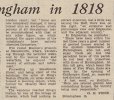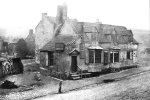"Yardley, in Worcestershire, distant three miles.
The road to this village lies up Deritend and Bordesley, then crossing the Warwick canal, you leave the ruins of Bordesley-house, and when through the turnpike, there being three roads you proceed along the centre, in which there are good accommodations for the pedestrian, but the carriage road does not appear to have experienced any improvement since it was first formed; for before you reach the village, the road is for a considerable distance from twenty to forty feet below the surface of the ground, on each side of it.
The church, which is dedicated to St. Giles, is an ancient pile of building. The tower and elegant spire above it appear at this time as firm and substantial as at their first erection, although they are so ancient that there are not any records to say when they were built: the body of the church is not so perfect. In the chancel there are several monuments to commemorate the Greswolds, an ancient family, formerly resident in this parish. The patronage rests with Edmund Mesey Wigley, Esq. The present vicar is the Rev. Joseph Fell. Adjoining the church-yard is an half-timbered building of large dimensions, which is a free school, liberally endowed, the salary of the master being £100 per annum.
The land in this parish being very suitable for making of tiles, innumerable quantities are there manufactured, for the supply of Birmingham."
The author seems to have got confused with the parish church of Sheldon, Saint Giles, and the parish church of Yardley, Saint Edburgha. Throughout the fascinating work are several mentions, as above, to roads being worn below the level of the surrounding land by a considerable amount. That must have made travel very hard in the wet and surely landslides must have been common?





